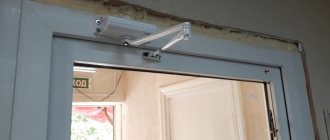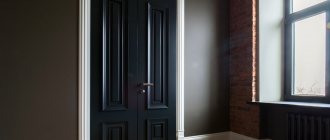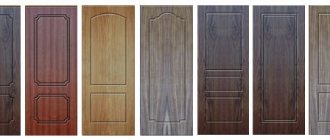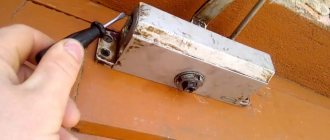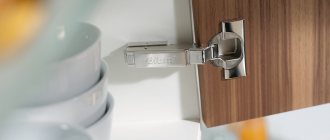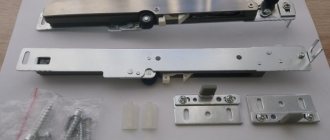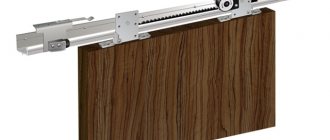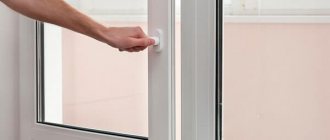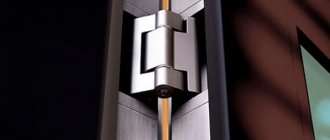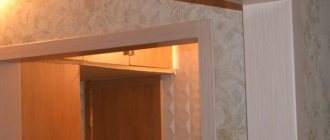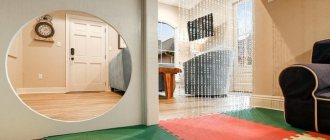Category: Accessories ( 2 ratings, average: 4.00 out of 5)
Published 04/10/2020 · Comments: · Reading time: 7 min · Views: Post Views: 12,250
Often we do not notice the difficulties when opening doors in an entrance hall, a shopping complex, or an office building. Although opening the front door, especially a metal one, is not an easy task. A door closer with the correct adjustment allows you to do this unnoticed. Our article will tell you how to adjust the door closer yourself when first mounting the door on the frame and in subsequent use.
What is the operating principle of the closer?
All types of door closers work on the same principle. Inside the structure there is a spring in a special oil solution. When the sash opens, the spring is compressed, and the oil solution moves into the vacant space. And when closing the canvas, the spring closes slowly due to the fact that the oil prevents it from making a sharp pop.
The finishing device is regulated by valves that set the oil flow rate. Therefore, adjusting the door closer with your own hands involves adjusting the required smoothness.
Some types of devices have additional functions controlled by separate valves. For example, fixing an open door, closing it further for better latching and fit. Additions will extend the service life of the door leaf.
Classification
According to global standards EN 1154, door closers are classified according to the closing force they can generate. They are divided into 7 classes, which are designated EN1-EN7. When choosing a class, pay attention to the inertia of the door, that is, the width of its leaf and weight at the same time. If different door parameters correspond to different classes, install a device of a higher class.
| Door closer class | Door leaf width, mm | Door leaf weight, kg |
| EN1 | up to 750 mm | up to 20 kg |
| EN2 | up to 850 mm | up to 40 kg |
| EN3 | up to 950 mm | up to 60 kg |
| EN4 | up to 1100 mm | up to 80 kg |
| EN5 | up to 1250 mm | up to 100 kg |
| EN6 | up to 1400 mm | up to 120 kg |
| EN7 | up to 1600 mm | up to 160 kg |
For example, the width of the door corresponds to class EN2, and the weight is EN4. They put it in 4th class, since a weaker force will not cope with the load.
There are door closers that belong to the same class. The characteristics then indicate a class with one digit - EN5. They have a small range of force adjustment - within one class. There are devices whose closing force is regulated within several groups. In this case, the range is marked with a hyphen - EN2-3, for example. The latter are more convenient to use - you can adjust the closing speed depending on the weather. But the cost of such models is higher.
Types of door closers
Before starting regulation, you need to know the types of closers. There are two classifications: by type of closing mechanism and by installation method.
| By installation method | By type of closing mechanism |
| Overlays (top) are mounted at the top. | The cam-slide design is used for lightweight types of doors, creating smooth closing. |
| Floor ones are installed below. | The gear-lever type is used for heavy-duty combination doors. |
| Frame (hidden) are installed on the floor or in a frame. |
Interesting! Door closers from the German company Dorma have become famous, they are in demand and there are many positive reviews on the Internet.
Setting the intermediate stroke
Usually the intermediate stroke is adjusted in unison with the main door stroke, but there are other options. For example, if you need to slightly reduce the speed halfway through the door closing. To do this, use the third adjusting bolt. This bolt serves to hold the door leaf in a certain position. For example, you need to add more closets to your apartment.
The screw can be adjusted so that the door remains open for a while, and only then begins to close.
Instructions for self-adjustment of the device
After installing the door leaf, it is necessary to install a closer. It must be located inside the building so as not to become contaminated by street dust and dirt. For installation you will need a ruler, a simple pencil, a drill and a screwdriver. And also a stool if the box is too big.
The fastening device is located in the same set with the door closer. The kit also includes instructions for easy DIY installation. When mounting, first fix the housing, then attach the lever rod.
Self-adjustment of the door closer begins with finding two adjusting screws. One sets the main door movement from 180 to 15 degrees, and the other the final stages.
Interesting! In modern devices, a third adjustment screw is installed to adjust the total force.
Device installation steps:
- The cover is removed, the valve for regulation is found and checked with the instructions from the kit.
- The first screw is turned clockwise to increase the closing rate, and in the opposite direction to decrease it.
- If necessary, the “hold open” function installs a locking lever when the doors are open 90 degrees.
- Check whether the structure is installed correctly.
Don't miss: How to make a reliable and functional canopy over the porch - simple instructions from experts
You cannot make more than two turns from the original location, so as not to break the device.
What to do?
If you were able to determine the reason for the door opening tightly, then you need to eliminate it. If the issue is the incorrect selection of the door closer in terms of power, then there is only one way out - change the device. The fact is that there are no technical capabilities to correct this error. The closer mechanism cannot be altered. Moreover, remember that all parts inside the device body are under pressure, and under no circumstances should you disassemble it! By the way, even if the opening force suits the user, a door closer that is too powerful on a light door will still not work correctly, which can lead to its breakdown.
As for incorrect installation, it can be corrected. This may lead to the appearance of extra holes in the door leaf, which may be visible, but in this case functionality is more important than aesthetics. The most effective way to adjust the opening force of a door with a closer is to move the device closer to the door hinges. This will increase the leverage and, accordingly, make opening easier.
Adjusting the closer during installation
The main adjustable parameters are: closing force, opening angle, and speed of movement of the blade. If the movement is too tight, children will not be able to use the doors, pets will be pressed against each other, and additional stress will occur during loading and unloading operations. And closing doors abruptly can result in bumps, bruises and pinched limbs.
Door movement speed
Once installation is complete, you need to learn how to adjust the door closer for ease of use. Self-adjustment of force is set with a screw. If the doors are too fast, turn the screw half a turn clockwise. With slow movements, the screw moves in the opposite direction by half a turn. The looser the screws are, the faster the oil moves through the structure and the faster the device operates.
After trying to turn the screws in different directions several times, you will understand what speed is appropriate. For entrance doors and balcony doors, quick closing is installed. It allows less insects, drafts and strangers to enter. Slow speed is set for interior paintings.
Installation of aftershock
It is very important to adjust the door closer according to the closing force. With a strong bang and rumble, the door frame will collapse. Therefore, it is necessary to find the optimal speed.
The aftershock acts on the last 25cm. from the outer edge of the door. It is adjusted in the same way as the main stroke - by changing the position of the screw. It needs to be turned so that the speed does not hit the jamb and blades too much. Usually the middle position is set, at which the structure is slowed down with a neat, complete connection.
Open Position Calibration
It is often necessary to keep the doors open when there is no intercom or when transporting furniture. This adjustment of door closers is made if the “hold open” functionality is available. Configuration occurs in the following way:
- Open the door at 90 degrees.
- A special lock is attached to keep the doors open.
Interesting! If you set a different degree, the function will not work.
To return the doors from a fixed position, the leaves are pulled towards themselves.
How to adjust the opening force?
Often you have to deal with a situation where the door closer makes it difficult to open the door.
It takes truly titanic efforts to move the door leaf from its place, and even more so to open it wide. What is the reason for this and is the door closer to blame? First, let's understand the terms. We have already written that immediately after installation, as well as when the season changes, the door closer needs adjustment. This is done using a simple screwdriver by tightening or loosening special adjusting screws located on the closer body. However, in this way it is possible to adjust only the closing force , that is, the force that the closer mechanism transmits to the door leaf. Accordingly, during the adjustment process, the speed of the door leaf will change in two segments of movement: from the opening angle to 18˚ and from 18˚ until the door is completely tightly closed.
But what about the force that needs to be applied to open the door? It is worth mentioning that we use the expression “ opening force ” metaphorically. This force itself is regulated by a person: after all, it is the user, and not the door closer, who opens the door. In fact, if the door opens too tightly after installing a closer on it, you need to somehow adjust the sensitivity of the mechanism to the force exerted by a person on the door leaf when opening. There is no special system for such adjustment. Moreover, if this adjustment is required, it means that the door closer is not working correctly.
Why can't I install a door closer?
Sometimes, having prepared well for installation and carried out everything in accordance with the manufacturer’s instructions, it is not possible to complete the installation. The reason for failure may be the incorrect selection of parts.
Don't miss: How to choose an electromechanical lock - features, pros and cons
Currently, there are many models of door closers produced for different types of door leaves. This especially often occurs when selecting a mechanism for metal doors. Perhaps the angle for securing the mechanism was set incorrectly, or the holes in the screws were displaced. Also, the purchased design may not match the width and weight of the canvas.
Sometimes, to successfully install a door closer, you need to move one link. To check, look at the evenness of the lever - if the position is not perpendicular to the doors (displacement), the link will need to be moved.
If, when checking the installation of the angle and displacement of the holes, no deviations are identified, then a complete replacement of the device will be required. You will need to select a closer with more power.
Support from NORA-M specialists
The above recommendations should not be taken as a guide to immediate action. Moving the door closer to another place is not a difficult task, but you still shouldn’t make extra holes in the door without firm confidence. To correctly assess the situation with the installation of the NORA-M door closer, you can contact us.
Technical specialists of the NORA-M brand are always in touch! For consultation, you can provide a photo of the installed door closer to make it easier for a specialist to identify the problem and ways to solve it.
In order to get advice, you can use the special “Technical Support” form on our website (the corresponding button is located in the upper right corner of any page of the site), or call.
The main reasons for adjustments during use
Sometimes, during long-term operation, it may be necessary to adjust the door closer, because the oil solution changes properties at different temperatures and affects the compression of the springs. Typically a summer change is required for hot weather and a winter change. They are adjusted in the same way as the initial installation - by moving the screws clockwise, as described in the schematic instructions.
In order to prevent the mechanism, a check is arranged once every six months when there is a strong change in temperature. Additionally, you can check the operation of the device in case of failures. Inspect and repair damage if necessary.
Loosen the closer spring
More often than not, during operation, opening the entrance becomes very difficult. Many people are interested in how to loosen the mechanism for convenient operation. To loosen, you need to turn the screw clockwise, but no more than 2 turns, so as not to break the mechanism.
Installation of aftershock
Now let's look at how to adjust the door closer to install the door closer. This mode allows the doors to close smoothly, leaving a small gap before closing completely. It also performs a function that ensures a tighter fit of the canvas to the frame.
In order to set the shutter, it is necessary to change the position of the second screw located on the closer body. When approximately 10-15 degrees remain until complete closing, the deceleration will work, and then the blade will be pulled to the end. The screw controls the speed of this movement.
The clap speed is adjusted using the adjusting screw number 2
Tips from experts on repairing door closers
Home adjustment of the door closer is subject to certain restrictions. They are needed for long and efficient operation. It is necessary not to load the doors with heavy things, because the weight will cause the structure to warp and breakage may occur. It is not recommended to prop up open sashes, because there is a “hold open” option for this.
Did you repair the door closer yourself?
Not really
When mounting, it is important not to twist the screws more than 2 turns from the original position. This is necessary to prevent the oil composition from leaking out. If the oil leaks, the device will cease to perform its main function, and repairing the problem is not easy.
It is also important to control distortions during surgery. If distortions appear during installation, then there will certainly be breakdowns during operation.
Many craftsmen are interested in how to remove the device when repairing it - in the reverse order: first remove the lever, and then unscrew the housing.
Before starting repairs, determine the cause of the problem. Main reasons:
- Natural. For example, showers and rains, temperature changes at different times of the year. Very negative weather changes affect plastic boxes and metal parts that are located outside.
- Blocking doors with various things, which does not have a function for calibrating the open position.
- Closing the canvas on your own, instead of the established speed setting.
- Selection of a closing mechanism that is not suitable for the dimensions of the sashes. If you choose a closer with insufficient power for doors with a large weight, then overload and distortion of the structure will occur.
Interesting! Overload of the structure appears in families with children, if small children ride and hang on the canvas.
Most often, two types of breakdowns occur: oil leakage or rod deformation:
Don't miss: How to properly embed a lock into an interior door: instructions for installing a lock, do-it-yourself latches
1 If the rod is deformed, you need to check the material from which it is made. If it is a regular steel alloy, then it is susceptible to corrosion. The rusted areas are cleaned and lubricated with a special anti-rust agent. If a break appears, you will need to work with a welding machine, and finally clean the seams well. When bending or bending, everything is straightened with a hammer. But you should use the hammer carefully so that the parts do not break due to overload. If there is too much distortion or rust, then a new part is purchased and replaced.
2 Leakage of oil solution occurs due to cracks. If everything leaks, the structure will have to be replaced with a new one. Because the device will become an ordinary spring and will slam very loudly without the possibility of regulation. The fault must be fixed as soon as possible so as not to lead to a complete replacement of the equipment. If there is a small crack in the body and the oil has not had time to completely drain out, then the damaged area is sealed with hermetic putty. If there is a large hole and significant oil leakage, the sealant will be useless - a hollow replacement will be required.
Some manufacturers may not add enough oil to the product body, which is why a slow closing rate is not achieved. To eliminate the malfunction, it will be necessary to refill through the screw holes with shock absorbers or solutions of motor oils with a synthetic composition.
Consequences of improper use
Despite the fact that high-quality devices have fairly high durability, they also sometimes experience premature failure.
If used incorrectly, even high-quality door closers fail
- Mechanical breakdowns of the closer: deformation of the rods, disruption of the functionality of the piston. Such breakdowns appear as a result of improper use of doors and excessive physical effort on the door leaf.
- There are situations when mechanisms use oil that is not intended for operation at sub-zero temperatures. It sharply increases viscosity, doors open/close with difficulty, and great physical effort is required.
- Sealing failure and oil leakage. The seals cannot withstand the pressure and burst. When using the doors, oil gradually leaks and air takes its place. In addition to deteriorating the appearance of the doors, the performance of the door closer is impaired.
- Installation of a rigid closer on plastic doors. These structures cannot withstand significant forces, the elements of the door frame become loose over time, and the mechanism body falls with all the extremely negative consequences.
The type of closer must match the door design
We remind you once again that the duration of use of the door closer largely depends on the consumers. If they follow all the manufacturers' recommendations, then no unexpected problems will arise.
Prices for entrance doors
Entrance doors
Cautions
Like any mechanism, a door closer can fall victim to unwise actions. In order to protect such a useful device from damage, you should follow some simple rules:
- To prevent the set diagonal from becoming skewed, under no circumstances should you hang heavy objects on the door leaf.
- While the door is closing, you should not put pressure on it, thereby trying to speed up its movement.
- The design of the closer must be in a level state; if a misalignment occurs, there is a risk of failure of the structure.
- You cannot turn the screws too much, as this will lead to oil leakage, which will adversely affect the operation of the mechanism. By the way, it is impossible to return the oil back at home.
- In order to hold the door in the open position, it is recommended to use a special function rather than propping the door with any object. This leads to a gradual breakdown of the mechanism.
- Before installing and adjusting the closer, you must carefully study the instructions supplied with the device by the manufacturer.
Having carefully studied all the above recommendations, every owner will know how to adjust their door closer so that it lasts as long as possible. In general, both the door closer itself and its adjustment are not something extremely complex and incomprehensible, and therefore, with sufficient theoretical training, everyone can master the adjustment processes.
Design options
According to the type of working mechanism, cam and gear devices are distinguished. The first ones are designed for installation on lightweight door structures. They provide easy and smooth door opening.
The design of the gear mechanism of the entrance door closer differs from the cam version in the presence of a spring and a gear system. The spring is compressed as a result of strong pressure on it when the door is opened. And when a person releases the door leaf, the spring opens on its own, the closing mechanism is activated, and the leaf is pulled tightly to the door frame.
Based on the type of drive, closers are divided into electric, hydraulic and thermal drives. The entire mechanism can be housed in a plastic or steel case. Also, different models of door closers are characterized by the power of opening/closing the door leaf.
